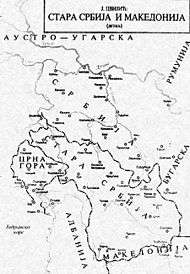Old Serbia
Old Serbia (Serbian: Стара Србија/Stara Srbija) is a term[1] used for the territory which was the core of medieval Serbia.[2] It included the regions of Raška, Kosovo and Metohija and the northwestern part of Macedonia.[3] The Serb population of this territory was referred to as Old–Serbians (Serbian: Старосрбијанци/Starosrbijanci).[4]
Etymology
Vuk Stefanović Karadžić referred to "Old Serbia" as a territory of the Serb people that was part of medieval Serbia prior to the Ottoman conquest.[5] The term originated in Serbian common speech and was introduced by the refugees of the Great Serb Migrations[6] who lived in territories of the Habsburg Monarchy.
It re-emerged in the aspirations of liberating these areas during the time of the Serbian Revolution and would later designate the areas to the south not yet liberated by 1833 and 1878.
History
In May 1877 a delegation of Serbs of Old Serbia presented their request to the government of Serbia to 'liberate' and unite Old Serbia with the Principality of Serbia.[7] They also informed representatives of the Great Powers and Emperor of Russia about their demands.[7] In the same year the Committee for the Liberation of Old Serbia and Macedonia was founded.[8] In the 1877 peace after the Serbo-Turkish War, the Serbs hoped to gain the Kosovo Vilayet and Sanjak of Novi Pazar to the Lim river.[9] However, the Treaty of San Stefano came as a shock, as they only received the small territory of Niš, Pirot and Vranje (ca. 200 square miles), which was smaller than the territory received by the Principality of Montenegro.[9] In 1913 the Sandžak, Kosovo and Metohija and Vardar Macedonia became part of the Kingdom of Serbia, and subsequently organized into the province (pokrajina) of South Serbia.
Legacy
The "Old Serbia" bank opened in Skopje in 1923 to dominate and accelerate the economy of the region.[10]
In Serbian historiography, the First Balkan War (1912-1913) is also known as War for Liberation of Old Serbia.
References
- ↑ Milovan Radovanović (2004). Etnički i demografski procesi na Kosovu i Metohiji. Liber Press. p. 33.
- ↑ Dedijer 2000.
- ↑ Ivo Banač (1988). The National Question in Yugoslavia: Origins, History, Politics. Cornell University Press. p. 38. ISBN 0801494931.
- ↑ Sebright & Irby 1877.
- ↑ Vladimir Stojančević (1988). Vuk Karadžić i njegovo doba: rasprave i članci. Zavod za udžbenike i nastavna sredstva.
- ↑ Milovan Radovanović (2004). Etnički i demografski procesi na Kosovu i Metohiji. Liber Press. p. 38.
- 1 2 Mitrović 1996, p. 68.
- ↑ Dragoslav Srejović; Slavko Gavrilović; Sima M. Ćirković (1983). Istorija srpskog naroda: knj. Od Berlinskog kongresa do Ujedinjenja 1878-1918 (2 v.). Srpska književna zadruga. p. 291. Retrieved 21 May 2013.
- 1 2 Jelavich 1983b, p. 29.
- ↑ http://scindeks.nb.rs/article.aspx?artid=1450-84869901123S. Missing or empty
|title=(help)
Sources
- Mitrović, Andrej (1996). Stojanu Novakoviću u spomen: o osamdesetogodišnjici smrti. Srpska književna zadruga. Retrieved 21 May 2013.
- Sebright, Georgina Mary; Irby, Adelina Paulina (1877). Travels in the Slavonic Provinces of Turkey-in-Europe. pp. 210–221.
Bibliography
- Jovan Hadži-Vasiljević (1906). Stara Srbija i Maćedonija: sa gledišta geografskog, istorijskog i političkog. Štamp. D. Dimitrijevića.
- Мирчета Вемић (2005). Етничка карта дела Старе Србије: Према путопису Милоша С. Милојевића 1871–1877. год. Geografski institut „Jovan Cvijić“ SANU. ISBN 978-86-80029-29-0.
- Ѳ. М Бацетич; Добрило Аранитовић (2001). Стара Србија: прошлост, садашњост, народни живот и обичаји. Историјски музеј Србије.
- Spiridion Gopčević (2008). Стара Србија и Македонија: фототипско издање. Народна и универзитетска библиотека "Иво Андрић" Приштина. ISBN 978-86-7935-113-5.
- Vladimir D. Vučković (2014). Stara Srbija i Makedonija: oslobođenje i uređenje. ISBN 978-86-88415-52-1.
- Todor P. Stanković (1910). "Putne beleške po staroj Srbiji, 1871-1898". (Public domain)
- Gopčević, Spiridion (1890). "Stara Srbija i Makedonija". (Public domain)
- Miloš S Milojević (1871). "Putopis dela prave (stare) Srbije". (Public domain)
- Jovanović, J. (1941). Južna Srbija od kraja XVIII veka do oslobođenja. Beograd: Geca Kon.
Further reading
- Jelavich, Barbara (1983a). History of the Balkans: Eighteenth and Nineteenth Centuries. 1. Cambridge University Press.
- Jelavich, Barbara (1983b). History of the Balkans: Twentieth Century. 2. Cambridge University Press.
- Ćirković, Sima (2004). The Serbs. Malden: Blackwell Publishing.
- Zarković, V. (2011). "The work of Serbian diplomacy on the protection of Serbs in old Serbia in the last decade of the 19th century" (PDF). Baština (30): 105–116.
- Raičević, Svetozar (1933). "Etnološke beleške iz Južne Srbije". Narodna starina. 12 (32): 279–284.
- Šešum, Uroš S. (2016). "Србија и Стара Србија: (1804-1839)". Универзитет у Београду, Филозофски факултет.
- Jagodić, Miloš. "Планови o политици Србије према Старој Србији и Македонији (1878-1885)." Историјски часопис 60 (2011): 435-460.
- Црквене прилике у Старој Србији од укидања Пећке патријаршије до Велике источне кризе (1766-1878), у: Историја и значај Призренске богословије : (поводом 140 годишњице од оснивања). - Ниш : Филозофски факултет : Призренска богословија Св. Кирила и Методија : Центар за црквене студије, 2013, 9-29.
- Jagodić, Miloš. "Извештај Василија Ђорђевића о догађајима у Старој Србији из јула 1854." Мешовита грађа 36 (2015): 195-206.
- NEDELJKOVIĆ, SLAVIŠA. "BETWEEN THE IMPERIAL GOVERNMENT AND REBELS (Old Serbia during the rebellion of the Shkodra Pasha Mustafa Bushati and the Bosnian aristocracy 1830–1832)." ISTRAŽIVANJA, Јournal of Historical Researches 26 (2016): 91-105.
- Šćekić, Radenko, Žarko Leković, and Marijan Premović. "Political Developments and Unrests in Stara Raška (Old Rascia) and Old Herzegovina during Ottoman Rule." Balcanica XLVI (2015): 79-106.
External links
- Dedijer, Jevto (2000) [1998]. "Stara Srbija". Давидовић.
| Wikimedia Commons has media related to Old Serbia. |



